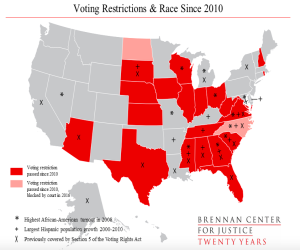Author Archives: Kathryn Kester '23
Voter Suppression in the 2016 Election
This article details voter suppression in the 2016 election and provides insightful data into the prevalence of the issue. According to the article, between 2010 and 2016, 20 states had enacted new laws designed to suppress voting. The 2016 election was notable in that it was the first election since the Supreme Court “gutted” Section 5 of the Voting Rights Act. Further, it is important to note that these laws have disproportionately affected people of color, which is reflected in the map below.

What is Voter Suppression?
https://www.adl.org/education/resources/tools-and-strategies/what-is-voter-suppression
This article explains the different ways that people’s votes have been suppressed, and gives examples of current policy to deter people from voting. Specifically, the article states that “These measures disproportionately impact people of color, students, the elderly, and people with disabilities.” According to this article, as of March 24, 2021, 47 states have collectively passed 361 bills which are discriminatory towards some group of voters. Below are some ways outlined in the article that voters are discouraged from placing a vote.
Early voting: Benefits senior citizens, working people, people with disabilities and more. Suppression laws make it more difficult to vote early by shortening the period of time for early voting.
Absentee voting: Exists for people who can’t vote in person at their polling location. In 2020 COVID played a big role in discouraging people from voting in person. Suppression laws include restricting absentee voting options by putting limitations on who can vote by mail, making it more difficult to receive vote by mail ballots, and generally making it more difficult to vote by mail.
Voter registration: Requiring proof of citizenship or other particular identification to register to vote, limiting the window to register to vote before the election, not allowing registration past a certain point, and limiting election day registration and automatic voter registration
Stricter voter ID laws: Specific identification required on the day of voting that wasn’t previously required, requirement of a photocopy of photo ID.
Voter purging: When a voter’s registration is removed by officials.
Disenfranchisement: People with felonies aren’t able to vote.
Precinct closures: Confusing, longer lines.
Gerrymandering: Redrawing voting district lines in the interest of increasing votes for one party.